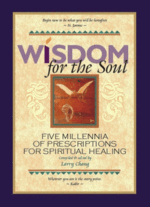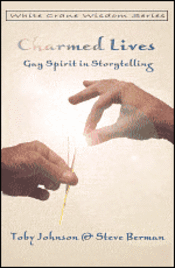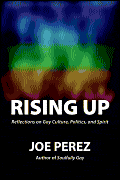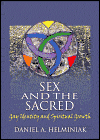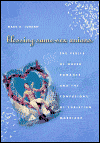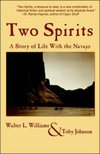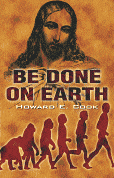
Be Done On Earth
By Howard E. Cook
PublishAmerica, pb,
185 pages, $19.95
Reviewed by Toby Johnson
A stranger appears in your life. He’s attractive, but even more, he’s charismatic, sexually alluring, but aloof. Everybody who meets him falls in love with him. And he’s mysterious, suddenly disappearing and then popping back up again in the most unexpected places and times, but always with coincidental (almost magical) significance. And he’s got a message for you—and for the world. And he wants you to spread it. He gives you a manuscript, and then he disappears again, leaving you with a mission.
This is certainly a familiar theme in mythological writing. From Richard Bach’s Messiah or Myles Connolly’s very Catholic Mr. Blue to the gospel stories themselves about Jesus, one of the ways “revealed” or spiritual insight is traditionally presented is as “the book within the book.” There’s a story about meeting the charismatic message giver, and within that story is the story or teaching he gives.
This happens in real life. It’s not just a theme in literature or mythology. It’s an actual experience people have. In my own life, my nicknamesake and first collaborator Toby Marotta entered my life in an almost magical way, invited me to help him edit his masterpiece Harvard doctoral dissertation into a publishable book, and then, leaving me with a copy to rewrite (and a message about the meaning of the gay rights movement), he disappeared with his exotic Parsi lover to search for crystals in India.
I just made it sound more magical and mysterious than it really was: Marotta’s partner was a geology professor from India who imported minerals as a sideline business to teaching. This was just a business trip and I was left with just a copyediting job. But it was the start of my own writing career — and of my own understanding of gay consciousness.
So when Howard Cook relates the tale of his meeting the elusive, charismatic Bradford Lightfoot Dare in the strangest of places over a period of many years, I was ready to believe the story on several levels from the mythic to the mundane. Cook’s story of Brad Dare is quite intriguing. He first shows up in a Trappist monastery, then as a nude model for life-drawing classes in Washington, DC. He’s a dance partner to debutantes and a most eligible bachelor in the nation’s capital. Next he’s a Jesuit seminarian studying Teilhard de Chardin, and a little later, he appears unexpectedly as a housemate in a hippie household in Greenwich Village in the apartment previously occupied by the New York Queen of the Gypies — with writer Norman Mailer indirectly making the reintroduction. Then he becomes a gay porn star in San Francisco and a character in the development of West Coast New Age thought along with Ken Kesey and Alan Watts.
Especially because the tale begins in the 1950s, I couldn’t help being reminded of Fred Demara, “The Great Imposter,” (played by Tony Curtis in the movie) who beguiled the American public in those days with his story of living many identities, including Trappist monk. But Bradford Dare comes across in Cook’s telling not as a daring adventurer (though look at his name!) thumbing his nose at convention and legalities, but as a dedicated and driven seeker of transcendent truths, though no less rebel.
Dare shows up again in Cook’s life many years later, after Cook has successfully marketed a couple of books. He’s been studying and thinking and making notes all these years, and now asks Howard Cook’s assistance in articulating and promulgating the wisdom and enlightened insight he’s gained.
And that’s the book within the book: Bradford Lightfoot Dare’s proposal for how to modernize Christianity and recreate the Church. Partly tongue-in-cheek and partly with multi-layered symbolism, Dare calls his message the first encyclical of Pope John the Beloved.
Blending modern-day physics and cosmology, a little Teilhard and a little Matthew Fox, comparative religion, some Joseph Campbell, intelligent New Age thought, progressed Christianity, American political idealism, evolutionary theory, postmodernism, (and here and there what seem like loose associations), Pope John the Beloved calls for a new Church of the Second Coming—also referred to (iconoclastically) as the Church of Kingdom Come – COKC (try pronouncing the acronym).
It’s a sex-positive religion based in an evolutionary model of human nature with an openly gay priesthood (with a somewhat progressed understanding of the role of homosexual consciousness in evolution). Some of the tenets of COKC are intentionally controversial (like the proposal that genetic science will soon allow humans to reproduce in the lab, avoiding all the dangers of unregulated breeding, and taking advantage of the opportunity to improve human nature at the molecular level). But the suggestions for an updated religious model come across as heartfelt and genuine.
I’ve tended to focus on the frame of the story rather than the content. Brad Dare would probably prefer I was writing about his ideas rather than Cook’s presentation. But I will leave readers to study Dare’s “encyclical” on their own: it’s a little overwhelming to summarize in a few paragraphs in a book review. I think men in the gay spirituality movement will recognize many of the themes (like the question “Was Jesus gay?”). But some of the ideas are fresh and come from unexpected directions (like the “final anthropic principle” in quantum cosmology). And, at any rate, it’s not so much the conclusions that will draw readers into the book as the process. Whether you agree with the conclusions or not, the debate is interesting and the argumentation thought-provoking.
For me, as reviewer, the most thought-provoking was the question whether Brad Dare is an alter-ego and literary device of Howard Cook’s multi-faceted mind or a “real” person. In a way, it doesn’t make any difference.
I must say I was disappointed at the end of the book that the framing story is not recapitulated. I wanted to know what happened to Brad Dare. All we get at the end is that he is working on a follow-up about the Church of the Gay Salvation.
Be Done on Earth is a neat example of an ancient literary and mythical dynamic by which wisdom is personified in a charismatic person who inspires those caught in his magic spell to discover their own insights and to surpass him. I was pleased to suspend disbelief and enjoyed the book — just as 30 years ago at the start of my writing career I was willing to suspend disbelief and let my friend and fellow Toby be an inspiration and watershed in my own life.
I wonder if there’s something “inherently gay” in finding inspiration in a charismatic person instead of an authoritarian institution or revealed text. I think that might be one of the subjects in Pope John the Beloved’s second encyclical.
This is just an excerpt from this issue of White Crane. We are a reader-supported journal and need you to subscribe to keep this conversation going. So to read more from this wonderful issue SUBSCRIBE to White Crane. Thanks!
